
Pyramid of Senusret I
Encyclopedia
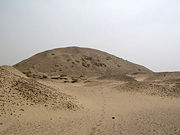
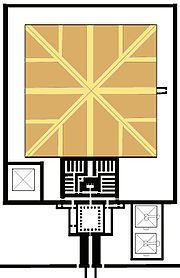
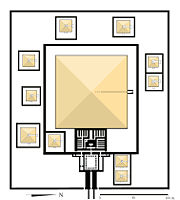
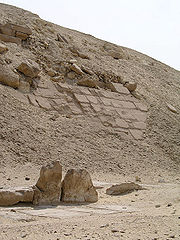
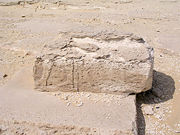
Ancient Egypt
Ancient Egypt was an ancient civilization of Northeastern Africa, concentrated along the lower reaches of the Nile River in what is now the modern country of Egypt. Egyptian civilization coalesced around 3150 BC with the political unification of Upper and Lower Egypt under the first pharaoh...
Pyramid
Pyramid
A pyramid is a structure whose outer surfaces are triangular and converge at a single point. The base of a pyramid can be trilateral, quadrilateral, or any polygon shape, meaning that a pyramid has at least three triangular surfaces...
built to be the burial
Burial
Burial is the act of placing a person or object into the ground. This is accomplished by excavating a pit or trench, placing an object in it, and covering it over.-History:...
place of the Pharaoh
Pharaoh
Pharaoh is a title used in many modern discussions of the ancient Egyptian rulers of all periods. The title originates in the term "pr-aa" which means "great house" and describes the royal palace...
Senusret I
Senusret I
Senusret I was the second pharaoh of the Twelfth Dynasty of Egypt. He ruled from 1971 BC to 1926 BC, and was one of the most powerful kings of this Dynasty. He was the son of Amenemhat I and his wife Nefertitanen. His wife and sister was Neferu. She was also the mother of the successor Amenemhat II...
. The pyramid was built during the twelfth dynasty of Egypt
Twelfth dynasty of Egypt
The twelfth dynasty of ancient Egypt is often combined with Dynasties XI, XIII and XIV under the group title Middle Kingdom.-Rulers:Known rulers of the twelfth dynasty are as follows :...
at el-Lisht
El-Lisht
Lisht or el-Lisht is an Egyptian village located south of Cairo. It is the site of Middle Kingdom royal and elite burials, including two pyramids built by Amenemhat I and Senusret I. The two main pyramids were surrounded by smaller pyramids of members of the royal family, and many mastaba tombs of...
, near the pyramid of his father, Amenemhat I
Amenemhat I
Amenemhat I, also Amenemhet I, was the first ruler of the Twelfth Dynasty . He ruled from 1991 BC to 1962 BC...
. Its ancient name was Senusret Petei Tawi (Senusret beholds the two lands
Upper and Lower Egypt
Ancient Egypt was divided into two regions, namely Upper Egypt and Lower Egypt. To the north was Lower Egypt where the Nile stretched out with its several branches to form the Nile Delta. To the south was Upper Egypt, stretching to Syene. The two kingdoms of Upper and Lower Egypt were united c....
).
Construction
The pyramid was 105 meters on each side with a height of 61.25 meters; the slope of the four faces was 49° 24' degreesDegree (angle)
A degree , usually denoted by ° , is a measurement of plane angle, representing 1⁄360 of a full rotation; one degree is equivalent to π/180 radians...
. The pyramid used a method of construction never before seen in an Egyptian pyramid; four stone walls radiated from the center built of rough-hewn blocks that decreased in size the higher their placement. The eight sections formed by these walls were then subdivided by three more walls, splitting the pyramid into 32 different units which were then filled with slabs of stone as well as debris. An exoskeleton of fine limestone
Limestone
Limestone is a sedimentary rock composed largely of the minerals calcite and aragonite, which are different crystal forms of calcium carbonate . Many limestones are composed from skeletal fragments of marine organisms such as coral or foraminifera....
then covered the structure. This new method of construction was not particularly efficient, however, and the completed pyramid suffered from stability problems. Unusually, clear evidence for the ramps used to construct the pyramid also remain.
Complex
Surrounding the actual structure was a comparatively large complex, which consisted of a mortuary temple, a rectangular structure with a courtyard in the center, and nine smaller pyramids for Senusret's queens. From the mortuary, a limestone causeway with carved statues set every 10 cubitCubit
The cubit is a traditional unit of length, based on the length of the forearm. Cubits of various lengths were employed in many parts of the world in Antiquity, in the Middle Ages and into Early Modern Times....
s ran to a public temple outside the perimeter wall of the compound. Little of this is visible today, however, because later Roman buildings were built over the complex.
Excavations
The pyramid has been severely damaged over time, and little of its limestone cladding remains. It now appears as little more than a hillock of stone.None of the excavations penetrated to the burial chamber due to high water levels, but much was learned about pyramid construction from the surrounding quarries, which contained one of the highest concentrations of ancient debris of any Egyptian archaeological site.
Gautier and Jequier
They pyramid was first explored by archaeologists Gautier and Jequier between 1894 and 1895.Metropolitan Museum of Art
From 1906 to 1943 the pyramid was excavated by a team from the Metropolitan Museum of ArtMetropolitan Museum of Art
The Metropolitan Museum of Art is a renowned art museum in New York City. Its permanent collection contains more than two million works, divided into nineteen curatorial departments. The main building, located on the eastern edge of Central Park along Manhattan's Museum Mile, is one of the...
headed by Lythgoe, Mace and Ambrose Lansing

